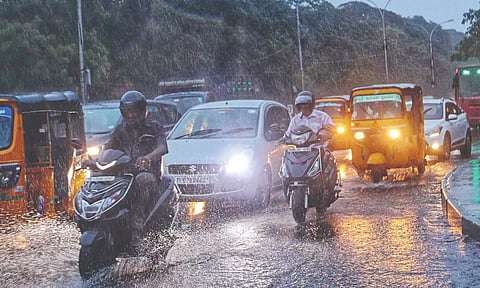

CHENNAI: With the country receiving below-normal rainfall during the southwest monsoon this year with a longer break-monsoon period, a report released by Climate Trends attributed the erratic monsoon to global warming and climate change.
“With disappointing performance (of monsoon) in August, the threat of drought was looming large over the country. However, monsoon rains revived during the second week of September, courtesy trail of monsoon systems in the Bay of Bengal. Monsoon rainfall deficiency recovered from -11 per cent on September 1 to -6 per cent on September 29,” the report said.
While Kerala, Jharkhand and Bihar reported a deficit rainfall of -36 per cent, -27 per cent and -24 per cent respectively, major contribution came from unusual regions like west Rajasthan, which recorded 42 per cent of excess rainfall. Saurashtra and Kutch region in Gujarat reported 48 per cent of excess rains. However, these excess rains were all due to very heavy to extremely heavy rainfall events throughout the season. A total of 221 out of 717 districts remained deficient to large deficient as of September 29.
“While the waxing and waning of Monsoon rainfall is very normal, climate change has doubled the variability factor of any weather event, be it extreme rains or heatwaves. The once-anticipated summer monsoon is becoming increasingly erratic and unreliable. The changing climate is shifting seasonal patterns, making dry years drier and wet years wetter. Such changes can cause more droughts or floods, posing water and food security challenges,” it added.
On the other hand, the absence of monsoon rains also paved the way for humid heat waves across East India, a phenomenon which is becoming worse due to global warming with excessive evaporation and moisture in the atmosphere.
Roxy Mathew Koll, Climate Scientist, Indian Institute of Tropical Meteorology said,” the capacity of air to hold moisture for a longer time has increased due to constant rise in land and sea temperatures. This, in turn, has influenced the intensity of monsoon rains. For instance, the Arabian Sea has warmed since January, infusing more moisture over northern and northwestern India. This continuous supply of moisture fed to the weather systems leads to increased rains, which also results in extreme weather events.”
Meanwhile the country witnessed its third longest break-monsoon period of the century in August 2023, after 2002 and 2009. The month saw two spells of back-to-back break-monsoon conditions. The initial spell that began on August 7 ended after 12 days on August 18. The second spell started on August 27 and lasted till early September.
The report pointed out that India has struggled with monsoon rain-triggered floods for many years. Over the last five decades, extreme floods in the country have risen by almost four-fold. Between 1970 and 2004, three extreme floods occurred per year on average. But after 2005, the yearly average rose to 11. Estimates show that South Asia could lose between 10-50% of crop production by the end of the century due to global warming effects.
An earlier study by Roxy Mathew Koll established that increasing sea-surface temperatures in the Indian Ocean correlate with the anomalies of precipitation in parts of South Asia and spatial distribution of rainfall.